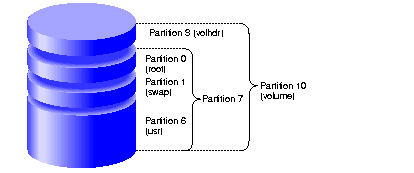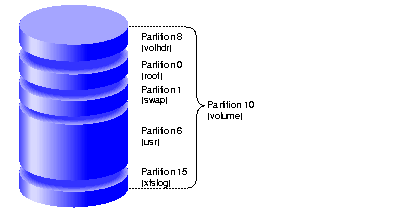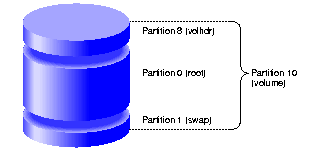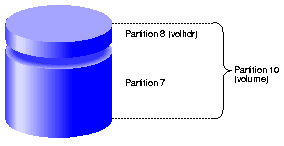
All other disks on the system other than the system disk are known as option disks.
Disks are shipped from Silicon Graphics with one of several "standard" partition layouts. You can list the partitions of a disk with the prtvtoc command (see the section "Displaying a Disk's Partitions With prtvtoc" in Chapter 2). The standard partition layouts are described and illustrated below.
Figure 1-4 and Figure 1-5 show the two common layouts of a system disk with separate partitions for the Root and Usr filesystems. The layout in Figure 1-4 is used for EFS filesystems and for XFS filesystems when the XFS log doesn't have its own partition (it is an internal XFS log). Figure 1-5 shows the partition layout when an XFS log partition is included (an external log).

Figure 1-4 : Partition Layout of System Disks With Separate Root and Usr

Figure 1-5 : Partition Layout of System Disks With Separate Root and Usr and an XFS Log Partition Separate root and usr partitions were standard on older systems and are still used on servers. In the original UNIX design, only the Root filesystem needed to be mounted to boot UNIX. This is not true for IRIX anymore--both filesystems must be mounted, so there is no longer the concept of the Root filesystem being a minimal subset of operating system software.
Figure 1-6 shows the layout of a system disk with a single partition for a combined Root and Usr filesystem and a swap partition. This arrangement is standard on most newer systems and applies to both EFS and XFS filesystems. However, restrictions on making the root partition part of a logical volume may make separate root and usr partitions a better choice than a single combined partition (see Chapter 6, "Logical Volume Concepts," for information about logical volume restrictions).

Figure 1-6 : Partition Layout of System Disks With Combined Root and Usr Figure 1-7 shows the standard layout of an option disk that doesn't have an XFS log partition. It has a single partition for data.

Figure 1-7 : Partition Layout of Option Disks Figure 1-8 shows the layout of an option disk with two partitions, one for data and one for an XFS log.

Figure 1-8 : Partition Layouts of Options Disks With XLV Log Subvolumes The default partition layouts are generic in nature and should be evaluated by the system administrator. After your system has been in operation for a few months, you may decide that a different arrangement would better serve your users' needs. Some points to consider in choosing partition layouts are:
Once disks have been partitioned, these partitions may be used as filesystems, as parts of a logical volume, or as raw disk space. Filesystems are described in Chapter 3, "Filesystem Concepts." Logical volumes are described in Chapter 6, "Logical Volume Concepts."